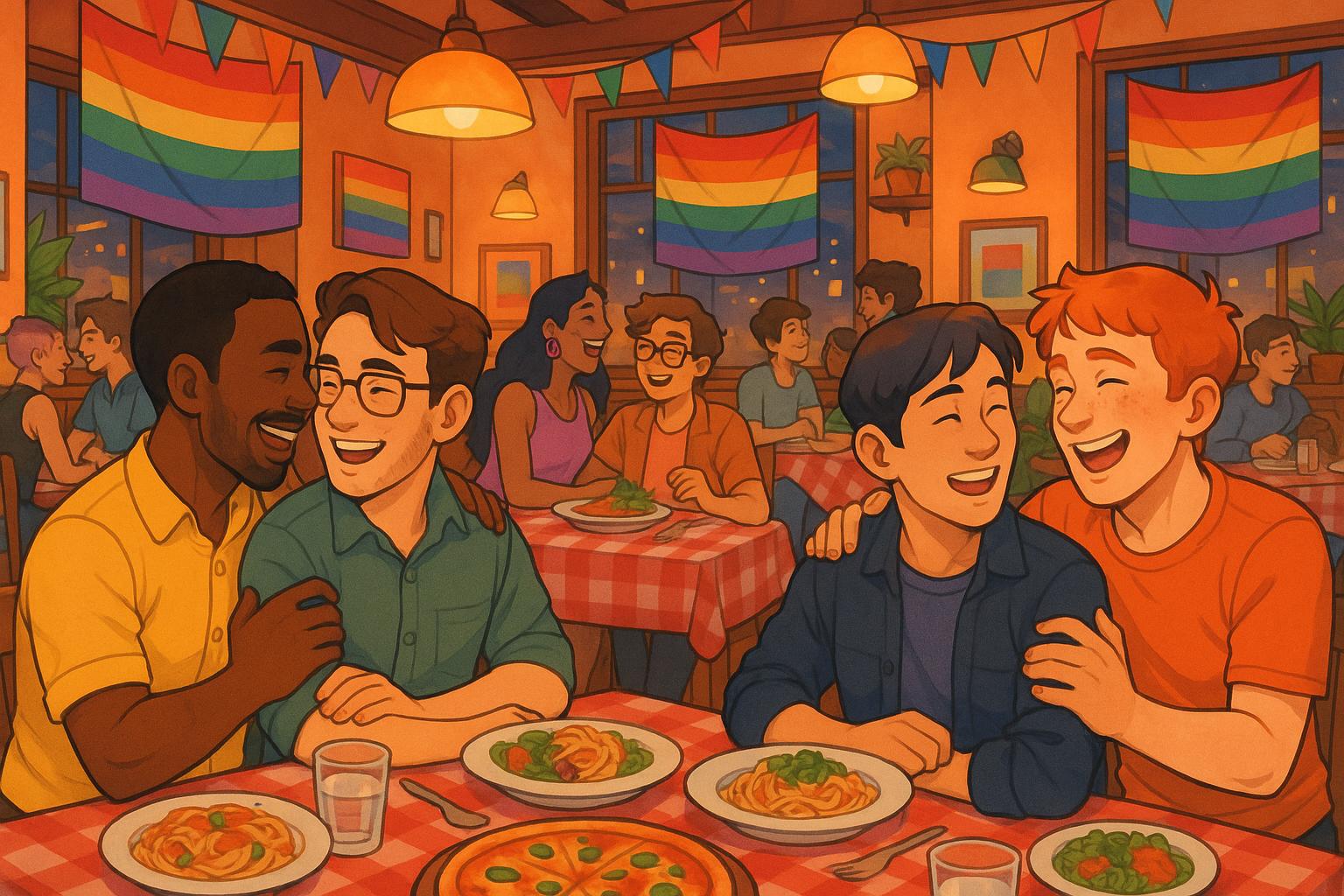Erik Piepenburg’s new book uncovers the enduring significance of gay restaurants across America as vital spaces of community, activism, and refuge amid ongoing social and political struggles.
Erik Piepenburg’s evocative narrative of American gay restaurants underscores their enduring significance as safe havens for the LGBTQ+ community. His reflections, particularly those surrounding the Napalese Lounge and Grille in Green Bay, Wisconsin, reveal how these spaces serve not just as dining establishments but as vital social centres where individuals can find solace and acceptance. “An amazing woman called Martha oversees it,” Piepenburg shares, highlighting the emotional stories he has encountered, including young people whose families struggle to fully accept their identities yet who find respite within the comforting walls of “Naps.” The essence of these venues is encapsulated in Piepenburg’s assertion that they have historically provided gathering points for marginalized groups, dating back to Walt Whitman’s time.
The book, titled Dining Out: First Dates, Defiant Nights, and Last Call Disco Fries at America’s Gay Restaurants, expands upon a 2021 article that Piepenburg wrote for the New York Times, exploring the rich and often underestimated history of these establishments. He defines “gay” restaurants not by the sexual orientation of their owners, but by the clientele that frequents them and the sense of community they foster amidst a backdrop of ongoing threats to LGBTQ+ rights, especially in today’s politically charged environment. This context provides a poignant reminder of the continuous struggles faced by the community, paralleling historical anecdotes with contemporary challenges.
Piepenburg’s exploration spans various notable locations, from family-run establishments like Annie’s Paramount Steak House in Washington D.C. and Casita del Campo in Los Angeles, to the revolutionary Bloodroot in Connecticut, which merges culinary arts with feminist social activism. Each restaurant painted in his vivid prose turns a page in the narrative of American LGBTQ+ history, revealing layers of personal and collective identity formed over shared meals. He even highlights locations like Flex, a gay sauna in Cleveland, which underscores the social functionality of food beyond traditional dining settings. The warmth of the community, whether over ravioli or at a bustling diner, proves significant for many who seek connection and camaraderie.
Among the historical gems Piepenburg recounts, the automat cafes popularised in the early 20th century emerge as intriguing spaces for social interaction among gay men. The narrative continues through the decades, from the vibrant scenes of New York City in the 1990s, capturing the spirit of establishments like the Big Cup and the once-thrumming Florent. The latter, under the stewardship of owner Florent Morellet, transformed into a beacon of hope and communal defiance as it became known for its outspoken activism and support for those living with HIV/AIDS during times of widespread fear and misunderstanding.
Piepenburg artfully interweaves poignant stories of individuals who have interacted with these restaurants as lifelines during both good and challenging times. He describes how elder patrons who may find themselves isolated can enjoy warm meals in spaces where they are welcomed and understood. This ongoing role of gay restaurants reveals their multifaceted purpose—a function that has evolved yet remains essential.
The book also addresses the role of restaurants as platforms for protest. From a landmark court case spawned at Papa Choux in LA to Piepenburg’s discoveries at Gallus in Atlanta, the venues have served as catalysts for social change and community resilience in the face of discrimination.
As Piepenburg reflects on the future of these spaces, he grapples with questions of relevance amidst a shifting cultural landscape. While some may argue that greater social acceptance of LGBTQ+ individuals negates the necessity of these safe havens, Piepenburg contends that they remain crucial, particularly in regions where community support is scarce. “Younger people told me they wanted ‘third spaces’ to meet each other—not bars, not work,” he notes, underscoring the ongoing need for inclusive venues within areas that still grapple with acceptance and equality.
Ultimately, despite the uncertainties that lie ahead, Piepenburg’s narrative is one of hope and celebration, assuring that the comforting atmosphere and camaraderie found in these establishments will likely endure, providing a necessary backdrop for storytelling, connection, and community bonding.
 Reference Map:
Reference Map:
- Paragraph 1 – [1], [2]
- Paragraph 2 – [1], [3], [4]
- Paragraph 3 – [1], [2], [5]
- Paragraph 4 – [1], [3], [6]
- Paragraph 5 – [1], [3]
- Paragraph 6 – [1], [3], [7]
Source: Noah Wire Services
- https://www.theguardian.com/books/2025/jun/06/american-gay-restaurant-history – Please view link – unable to able to access data
- https://www.theguardian.com/books/2025/jun/06/american-gay-restaurant-history – An article discussing the history and significance of American gay restaurants, highlighting their role as safe spaces for the LGBTQ+ community.
- https://www.nytimes.com/2021/06/15/books/review/dining-out-erik-piepenburg.html – A review of Erik Piepenburg’s book ‘Dining Out: First Dates, Defiant Nights, and Last Call Disco Fries at America’s Gay Restaurants’, exploring the cultural impact of gay restaurants in America.
- https://www.hachettebookgroup.com/titles/erik-piepenburg/dining-out/9780306925610/ – The official page for Erik Piepenburg’s book ‘Dining Out’, detailing its content and significance in LGBTQ+ history.
- https://www.nytimes.com/2021/06/15/books/review/dining-out-erik-piepenburg.html – A review of Erik Piepenburg’s book ‘Dining Out: First Dates, Defiant Nights, and Last Call Disco Fries at America’s Gay Restaurants’, exploring the cultural impact of gay restaurants in America.
- https://www.nytimes.com/2021/06/15/books/review/dining-out-erik-piepenburg.html – A review of Erik Piepenburg’s book ‘Dining Out: First Dates, Defiant Nights, and Last Call Disco Fries at America’s Gay Restaurants’, exploring the cultural impact of gay restaurants in America.
- https://www.nytimes.com/2021/06/15/books/review/dining-out-erik-piepenburg.html – A review of Erik Piepenburg’s book ‘Dining Out: First Dates, Defiant Nights, and Last Call Disco Fries at America’s Gay Restaurants’, exploring the cultural impact of gay restaurants in America.
Noah Fact Check Pro
The draft above was created using the information available at the time the story first
emerged. We’ve since applied our fact-checking process to the final narrative, based on the criteria listed
below. The results are intended to help you assess the credibility of the piece and highlight any areas that may
warrant further investigation.
Freshness check
Score:
8
Notes:
The narrative is based on Erik Piepenburg’s forthcoming book, *Dining Out*, scheduled for release on 3 June 2025. An earlier version of this content appeared in a 2021 New York Times article by Piepenburg, indicating that the core material has been previously published. The recent publication date of the book and the article suggests that the content is relatively fresh. However, the earlier appearance of similar material may affect the freshness score. ([hachettebookgroup.com](https://www.hachettebookgroup.com/titles/erik-piepenburg/dining-out/9780306832192/?utm_source=openai))
Quotes check
Score:
7
Notes:
The quotes attributed to Piepenburg in the recent narrative appear to be consistent with those from the 2021 New York Times article, suggesting they have been reused. This reuse of quotes may indicate recycled content. ([hachettebookgroup.com](https://www.hachettebookgroup.com/titles/erik-piepenburg/dining-out/9780306832192/?utm_source=openai))
Source reliability
Score:
9
Notes:
The narrative originates from The Guardian, a reputable UK-based news organisation, which enhances its credibility. The inclusion of quotes from Erik Piepenburg, a journalist for The New York Times since 2004, further supports the reliability of the information presented. ([hachettebookgroup.com](https://www.hachettebookgroup.com/titles/erik-piepenburg/dining-out/9780306832192/?utm_source=openai))
Plausability check
Score:
8
Notes:
The narrative presents a coherent and plausible account of the history and significance of American gay restaurants, supported by quotes from Erik Piepenburg. The consistency of the quotes with previous publications suggests that the information is accurate. However, the reuse of content from earlier sources may raise questions about the originality of the narrative. ([hachettebookgroup.com](https://www.hachettebookgroup.com/titles/erik-piepenburg/dining-out/9780306832192/?utm_source=openai))
Overall assessment
Verdict (FAIL, OPEN, PASS): OPEN
Confidence (LOW, MEDIUM, HIGH): MEDIUM
Summary:
The narrative is based on Erik Piepenburg’s forthcoming book, *Dining Out*, scheduled for release on 3 June 2025, and incorporates quotes from his 2021 New York Times article. While the source is reputable, the reuse of content and quotes from earlier publications may affect the freshness and originality of the narrative. Therefore, the overall assessment is ‘OPEN’ with a medium confidence level.













